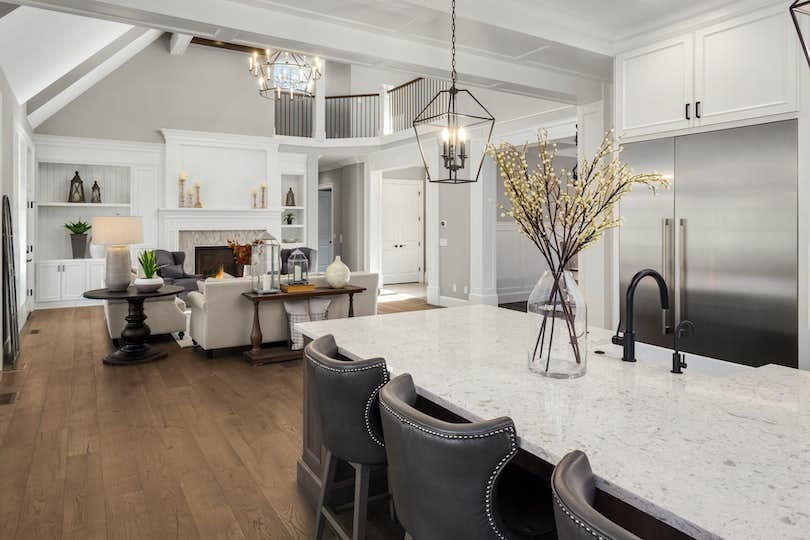
Selling your home is a long, demanding process, with tough decisions like determining the right asking price and picking the best realtor. But the most important step in your home sale might just be staging your home.
When buyers first see a home, they make up their minds within a very short time. That makes your home’s first impression incredibly important. Everything — from the furniture, to the floors, to the art hanging on the walls — has to be just right before you open your doors to buyers. If your home's appearance falls short of expectations, you risk leaving money on the table or derailing the sale entirely.
So how do you stage your home to maximize its appeal? Here are 20 of our best pointers.
1. Refresh your landscaping
Whether you’re selling a modest starter home or a million-dollar mansion, step one is to maximize your home’s curb appeal. Make sure the path to the doorway is clean, free of weeds, well-defined, and clear of any obstructions. Consider adding some color by installing window boxes of flowers and freshening up any graveled or mulched areas. If you didn’t repaint your home’s exterior, consider a power washing, which can be almost as effective and much less costly.
2. Spruce up the front door
Let’s start at the beginning. Studies have shown that the right front door can add thousands of dollars to your sale price, while the wrong front door can subtract thousands. A 2021 survey by BEworks and Zillow found that buyers were willing to pay up to $6,500 more for a home with a black or a slate gray front door, while colors like pale pink (also known as “millennial pink”) and a paler, cement gray were huge turnoffs to most buyers.
3. Don’t overlook the entryway
A lot of sellers put all their effort into primary home areas like the kitchen and bathrooms, while overlooking transitional (but still important) areas like the entryway. This is literally the first look your buyers are going to get at the inside of your home, so make it a pleasant one. If you’re like most people, your entryway is cluttered with coats, shoes, boots, umbrellas, mail, and who knows what else. Clear out all of that stuff, clean the walls and floors, and install a high-wattage light bulb to make your entryway look bright and welcoming.
4. Remove some of your furniture
Experts suggest removing at least half your furniture before showing your home — maybe more, if you have bulky pieces or have more furniture than average. Subtracting half your furniture will make your home seem roomier and larger.
Donate your unwanted furniture, or put it into storage to use in your next home. If your remaining furniture is severely out of fashion, consider buying new pieces for your showings.
If this all sounds like too much work, you can always sell your home as is to a cash buyer.
5. Don’t forget to declutter storage areas, too
Buyers are going to open every cupboard, closet, and cabinet. If every storage area they look into is packed full of stuff, they’re going to assume the home doesn’t have enough storage. Follow the same principle as you did with the furniture, and make sure your storage is half full at most.
6. Be sure to deodorize
A well-staged home isn’t just a visual experience. Get your home smelling fresh and pleasant. If you have pets, be sure to steam the carpets, and give special attention to areas where litter boxes or pet food lived. Air out as much of the home as you can, and if any areas remain musty or mildewy, use air fresheners or scented candles.
Don’t overlook your kitchen sink and garbage disposal. Grind a lemon in the garbage disposal before showings to freshen it up.
7. Depersonalize — but not entirely
Home staging experts often advise their clients to make their homes less personal and more neutral. This means removing family photos and other items that stand out too much, such as artwork, wall hangings, and unique pieces of furniture.
You want buyers to be able to project their own tastes onto your space, and that’s very difficult if your own aesthetic is too dominant. A home that has an appeal that’s too narrow or overpowering will only attract a small number of buyers, which could leave you mulling over lowball offers or scrambling to claw back a few bucks with a lower commission rate.
At the same time, don’t make your home completely sterile. You want it to look like a home, not a hotel. Keep a few strategic, tasteful items so your home still feels warm.
8. Arrange your furniture into “zones”
Don’t just push all the furniture up against the wall — this actually makes your space look smaller, not larger. Arrange the furniture into zones or areas that suggest specific uses — chairs facing each other, with an end table in between, for example. Just make sure you leave clear traffic paths through the rooms.
9. Maximize light
There’s nothing more flattering than natural light, so let in as much of it as possible. Remove heavy, obstructive window treatments like drapes or blinds, and wash your windows so they’re as clear as possible. If trees or bushes are blocking your windows, have them trimmed.
10. Standardize your wall hangings
Items like paintings, mirrors, and other wall hangings should be placed at eye level. Go through your rooms and place all wall items that are too high or too low at the same eye-level height.
11. Give every room a focal point
Each room should be oriented around a central focus — for example, a fireplace, bay window, or conversation pit. Decide what each room’s logical focal point is, and then rearrange your furniture around that point.
12. Don’t leave any rooms empty
Leaving any rooms vacant and unfurnished is a big mistake. Even if it’s just a spare bedroom or a workshop, place a few pieces of furniture in the room to give the room an identity. Leaving it empty could be unsettling to buyers who are expecting a warm, personal living space. Not to mention that, counterintuitively, an empty room looks much smaller than a furnished one.
13. When painting, keep it light
If you decide to repaint, stay away from divisive colors that are too dark (e.g., black, navy blue) or too vivid (e.g., lemon yellow, pink). Stick with unobtrusive, neutral colors like beige, light gray, or off-white.
14. Don’t forget the floors
Your floors should get as much attention as your walls. Get rid of any area rugs that are worn or stained, and consider replacing any dingy wall-to-wall carpeting. If your hardwood floors are looking scuffed, have them refinished and waxed. Buyers pay special attention to bathrooms, and since they have relatively small footprints, retiling the bathroom floors is an inexpensive way to make a positive impression.
15. Don’t worry about practicality
Many sellers worry too much about functionality when they’re staging their homes. For example, when they rearrange their living room, they reflexively face their sofa and chairs toward the television. But staging is all about making your home look good — not actually putting together a functional living space. Arrange your rooms in whatever manner looks best, even if the sofa faces the wall.
16. Accessories matter
As we mentioned above, removing all personal items can leave your home looking a little sterile. Add back in a few tasteful items like artwork or coffee table books to give your home some character.
Some subtly scented candles can give your home a pleasant vibe, as well as fresh flowers in the main rooms. Just stay away from using fake flowers, as they can make your home seem impersonal and cold.
17. Don’t forget pillows and linens
Adding large throw pillows to your sofa can make the living room more welcoming. Opt for solid, neutral colors instead of busy patterns or bright colors. While you’re at it, put clean white towels in all the bathrooms, and put fresh sheets and blankets on your beds.
18. Stage your backyard and deck, too
We’ve touched on the front yard and the house, but buyers will look over your backyard, too. Outdoor space is a major selling point for most buyers, so even if you only have a small backyard, make sure it’s looking its best. Completely declutter it, and get it looking vibrant and neat. If you have a wooden deck, have it refinished and freshly stained.
19. Put up some mirrors
Many home staging tips are intended to make your home look brighter and larger. Larger homes get larger offers, and larger offers lead to larger sale prices, and larger sale prices give you the leverage you need to negotiate a better fee with your agent.
Short of actually building an addition to your home, nothing makes a space seem larger than the addition of some mirrors. Hang mirrors in any rooms that need a boost. Try to place them so they catch and reflect natural light. In keeping with our earlier tip, keep them roughly at eye level to maximize their usefulness.
20. Clear your counters
In the kitchen, remove kitchen accessories like knife blocks or coffee machines from the counter, and place them out of sight. You want your counters to be as open and uncluttered as possible. The same applies to bathrooms. Put toiletries, razors, toothbrushes, and bottles where buyers won’t see them. Whether you’re selling with your city’s top agent, or you’re listing it on your own, don’t give buyers even the smallest reason to have doubts about your home.
